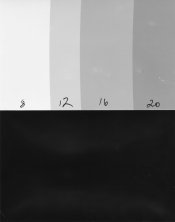I've been shooting Arista Edu #2 graded RC paper in my 4x5 cameras for some time. I reversal process the paper using potassium dichromate bleach and sodium sulfite clearing bath. I shoot at ISO 3 and develop to completion for both first and second development. The graded Arista paper is rated at P400.
The results have generally been quite good using both traditional lenses and pinholes, except for the excessive contrast. I decided to explore preflashing the paper before exposing in the camera to see if I could bring up the shadow detail and reduce the contrast.
In the studio, I used my Graflex Super Graphic and set up a test subject, s simple roll of birch bark. Lighting was 2-2400ws Speedotron flash heads on either side of the camera illuminating the subject at 45 degrees from each side. Distance from each 11 inch polished reflector to the subject was 30 inches.
As my light meters are all overwhelmed with that level of illumination, I ran some test prints:

I settled on f/32 as the exposure for the preflash tests.
Using a test strip, I set my Beseler Dual Dichro 23C enlarger to 22 inches from the bed, with the Dichro head set to 30/30/30. The 35mm enlarger lens was set to f/16. I ran a test strip at 4 second increments and settled on exposures of 0, 8, 12, and 16 seconds of preflash. The results are below:

All images are scanned together, BTW.
I didn't see much improvement in shadow detail until the 12 second preflash, with further improvement at 16. Note that the test strip is NOT reversal processed, so darker on the strip means lighter in the shadow areas of the prints.
Based on these tests, I think I'd go with 15 seconds for most shooting.
I was surprised at the level of preflash needed to see improvement in the reversal prints, but this seems consistent with others' experience with reversal processing. I would expect paper negatives to require much less preflashing.
I hope this is helpful.
Regards,
Don
The results have generally been quite good using both traditional lenses and pinholes, except for the excessive contrast. I decided to explore preflashing the paper before exposing in the camera to see if I could bring up the shadow detail and reduce the contrast.
In the studio, I used my Graflex Super Graphic and set up a test subject, s simple roll of birch bark. Lighting was 2-2400ws Speedotron flash heads on either side of the camera illuminating the subject at 45 degrees from each side. Distance from each 11 inch polished reflector to the subject was 30 inches.
As my light meters are all overwhelmed with that level of illumination, I ran some test prints:
I settled on f/32 as the exposure for the preflash tests.
Using a test strip, I set my Beseler Dual Dichro 23C enlarger to 22 inches from the bed, with the Dichro head set to 30/30/30. The 35mm enlarger lens was set to f/16. I ran a test strip at 4 second increments and settled on exposures of 0, 8, 12, and 16 seconds of preflash. The results are below:
All images are scanned together, BTW.
I didn't see much improvement in shadow detail until the 12 second preflash, with further improvement at 16. Note that the test strip is NOT reversal processed, so darker on the strip means lighter in the shadow areas of the prints.
Based on these tests, I think I'd go with 15 seconds for most shooting.
I was surprised at the level of preflash needed to see improvement in the reversal prints, but this seems consistent with others' experience with reversal processing. I would expect paper negatives to require much less preflashing.
I hope this is helpful.
Regards,
Don
Last edited:




